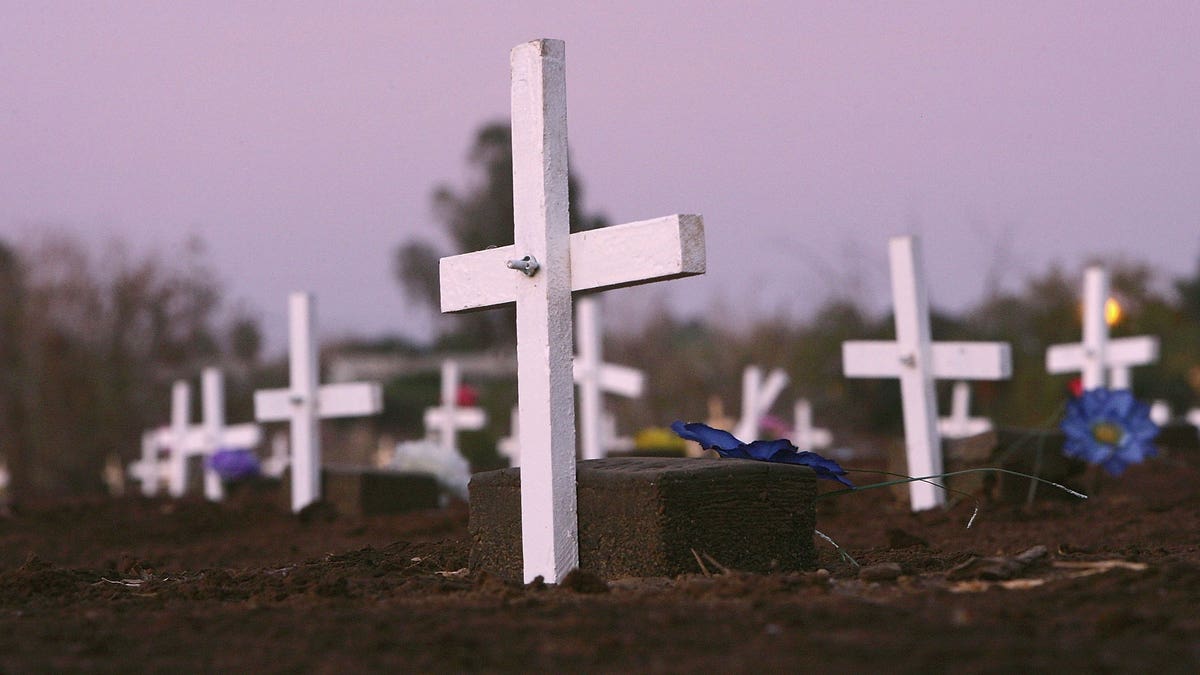
CALEXICO, CA - FEBRUARY 02: Grave marker crosses are seen in the night after activists on the "March for Migrants" placed them on the graves of approximately 400 people in a cemetery plot set aside for unidentified people who died trying to cross illegally into the US from Mexico on the anniversary of the signing of the treaty of Guadalupe-Hidalgo on February 2, 2006 in Holtville near the border town of Calexico, California. Among a host of issues that the "March for Migrants" caravan is pushing are opposition to HR 4437 bill to beef up border operations, demand for action in the case of Guillermo Martinez Rodriguez who was allegedly killed by US Border Patrol agents, and to bring attention to some 4000 migrants who have died since the inception of Operation Gatekeeper in 1994 to increase border patrols, according to the group. The activists will travel throughout much of the West and along the US/Mexico border ending in Washington D.C. with three days of rallies and visits to legislators starting February 18. (Photo by David McNew/Getty Images) (2006 Getty Images)
Flowers left by anonymous well-wishers on top of small mounds of dirt mark the end of the journey for dozens of undocumented migrants who died along the way but were never identified.
At the Brooks County, Texas, cemetery, more than 50 small metal plaques mark the gravesites in just one of the various areas where John Does — their real names are unknown — are buried.
As he walked along the markers, Rafael Hernandez, the founder of the California-based immigrant rescue group Angeles Del Desierto, wondered if any of those graves contain the remains of the many cases that he is currently investigating.
“Every day I get phone calls from fathers looking for sons, from sons looking for mothers — all looking for answers or closure,” Hernandez said. “I can’t help but wonder if those answers are here.”
In 2012, authorities in Brooks County — which is more than 70 miles from the U.S.-Mexico border — reported finding 129 bodies of dead migrants. Of those, 47 were not identified and ended up in unmarked gravesites. The increase in migrant deaths points to a shift in migration patterns, from the favored routes in the West Coast to the now increased transit in Texas, said Tom Power, a legal advocate for the Texas Civil Rights Project.
The theory about a shift in migration is supported by recently released statistics by the U.S. Border Patrol which show that, just in 2012, agents caught 97,762 immigrants — nearly twice as many as the 59,243 arrested in 2011.
Hernandez began travelling to Brooks County and the Rio Grande Valley in 2012 after receiving numerous calls from families that had lost a loved one as they made their way north.
“The majority of those calls pointed to here in Falfurrias," he said. "This is very dangerous terrain where a person can easily get lost and fall prey to the elements or even worse fall prey to criminals.” “
The city of Falfurrias lies along U.S. 281 and is just north of a U.S. Border Patrol checkpoint which presents the last official roadblock in the undocumented immigrants' journey.
In response to those cries for help, Hernandez and his organization took to vast swaths of land near and around the checkpoint — private ranches — in search of bodies from migrants that died along the way. Even if bodies are found, many times identifying them can be very difficult if they are not carrying any documents.
Unlike other counties, Brooks County doesn’t conduct DNA testing on unidentified bodies — a policy which violates Texas law, according to Joseph Martin, a lawyer with the South Texas Civil Rights Project.
“The law is very clear in its prescription for how to handle these bodies,” Martin said. “State law mandates the collection of DNA when a set of remains is otherwise unidentified.”
Authorities in Brooks County are not able to conduct DNA testing because of the financial burden that the sudden increase in migration has placed on the county’s health fund, said Grace Mora, the chairwoman of the county’s Health Advisory Committee.
“We are well aware of the situation, but we need the help of the federal and state government,” Mora said. “Our health fund is depleted.”
To help alleviate the lack of funds and try to resolve the issue, the Texas Civil Rights Project has contacted the Health Services Center at the University of North Texas, which has offered to provide free DNA testing as part of a project the center is doing — compiling a database of John Does.
“This is something that we will definitely study further and hopefully move forward,” Mora said. “Our heart is in the right place. We will do all we can to help.”
